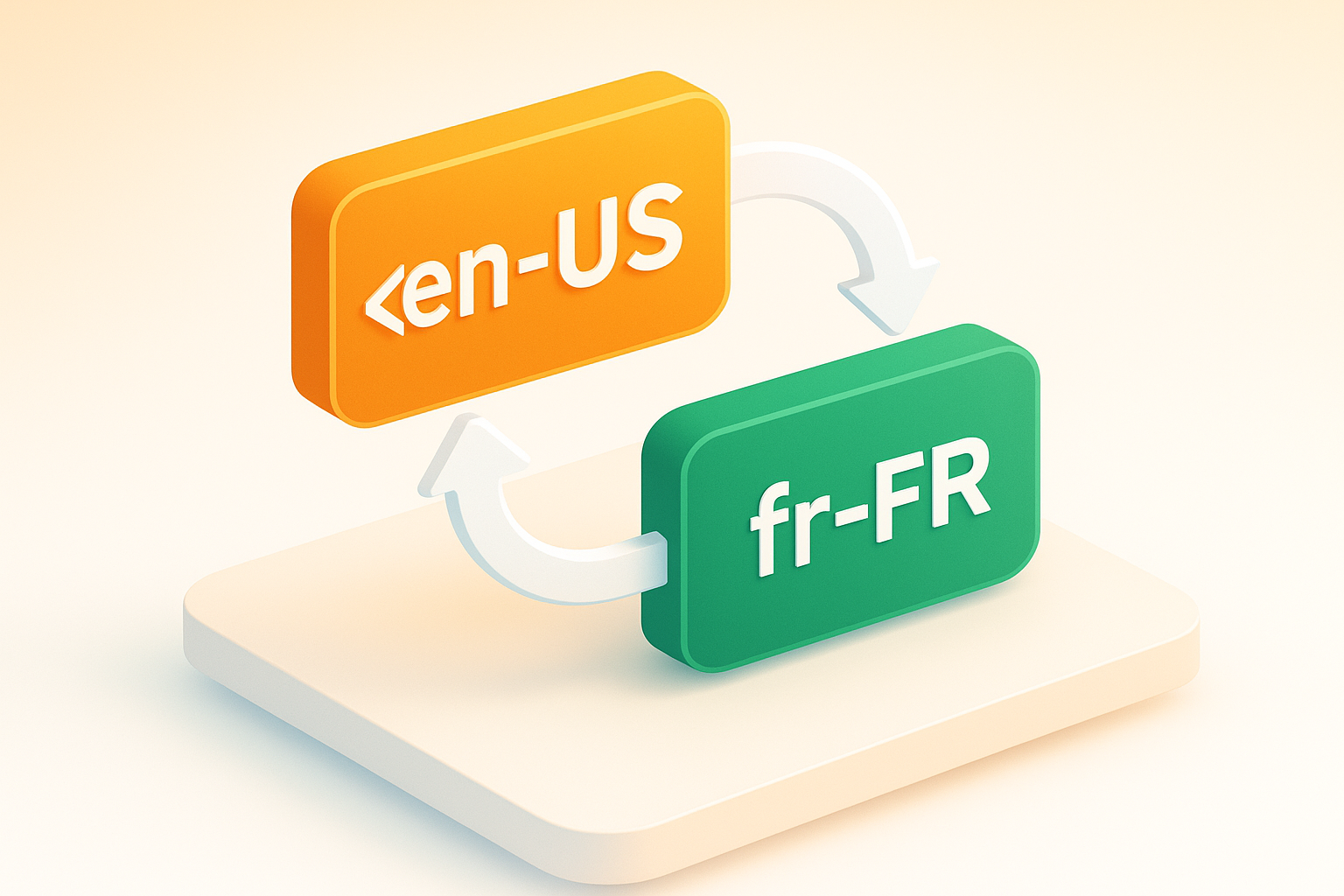Key Takeaways
- Many eCommerce founders fail to implement hreflang correctly on their multilingual WordPress stores.
- Incorrect hreflang setup causes customers to see the wrong language version of product pages.
- Poor hreflang implementation can lead to a significant drop in conversion rates, sometimes by 40%.
- Proper hreflang usage is essential for successful international expansion of WordPress eCommerce sites.
Table of Contents
- The Critical Role of hreflang in WordPress Multilingual SEO, and Why eCommerce Brands Can’t Ignore It
- The Anatomy of hreflang, Codes, Structure, and the Real SEO Impact
- Agentic SEO Implementation, Manual vs Plugin-Driven hreflang in WordPress
- Step-by-Step: Manual hreflang Tagging in WordPress, Code, Sitemaps, and Real-World Pro Tips
- Scaling Up, Always-On Plugin Solutions for hreflang Tagging (Top 4 Compared)
- Validating and Auditing hreflang, How to Avoid Costly Indexation Errors
- Troubleshooting Advanced hreflang Issues in Complex WordPress + WooCommerce Setups
- Optimizing for AI Answer Engines and Google’s SGE, Why Correct hreflang Unlocks Compounding Traffic in 2025+
- Future-Proofing Your International eCommerce SEO with Always-On Agentic Content Systems
hreflang WordPress Mastery: AI-Optimized Growth Guide
Most eCommerce founders expanding internationally make the same costly mistake: they launch multilingual WordPress stores without proper hreflang wordpress implementation, then wonder why their French customers see English product pages and their conversion rates tank by 40%. Programmatic AI SEO & AEO Service can help you avoid these pitfalls and ensure your multilingual setup is optimized from day one.
Here’s what’s happening: Google’s AI-powered search results now appear in 13% of all queries, and these answer engines rely heavily on language and region signals to serve relevant content. Without correct hreflang tagging, you’re not just losing traffic, you’re invisible to the AI systems that increasingly influence buying decisions. As someone who’s architected always-on content systems for 7 and 8-figure brands doing over $250M in combined revenue, I’ve seen this pattern destroy otherwise solid international expansion strategies. See real-world SEO & PPC case studies to understand how strategic hreflang implementation drives measurable growth.
The opportunity is massive. Brands that nail wordpress hreflang implementation don’t just avoid cannibalization, they unlock compounding organic growth across every market they enter. This guide delivers the strategic frameworks and operational systems to dominate multilingual SEO, built for Google’s evolving landscape and the new answer engines. For a comprehensive roadmap, download the complete Traffic Blueprint and accelerate your international SEO results.
The Critical Role of hreflang in WordPress Multilingual SEO, and Why eCommerce Brands Can’t Ignore It
Think of hreflang wordpress tags as traffic signals for Google’s global highways, they tell search engines which language and regional version of your content to serve to specific audiences. For Shopify and WordPress brands expanding beyond their home market, these tags are the difference between seamless international growth and expensive traffic cannibalization.
The stakes have never been higher. With AI answer engines processing 2.5 billion daily prompts and influencing purchase decisions, incorrect language targeting doesn’t just hurt your rankings, it removes you from the conversation entirely. When a Spanish searcher gets served your UK English product page, conversion rates typically drop 50-70% compared to properly localized experiences.
Real Impact: One of our Shopify fashion clients saw their French market traffic increase 180% within 60 days of implementing proper hreflang, simply because Google finally understood which products to show French searchers versus UK customers browsing similar items.
Without hreflang, you’re fighting three growth killers simultaneously: duplicate content penalties, poor user experience from mismatched language/region combinations, and complete invisibility in AI-powered search results that increasingly drive qualified traffic to eCommerce stores.
The Anatomy of hreflang, Codes, Structure, and the Real SEO Impact

Every hreflang wordpress implementation follows a precise syntax combining language codes (ISO 639-1) with optional region codes (ISO 3166-1 Alpha 2). The format looks like this: hreflang="en-US" for US English or hreflang="fr-FR" for French France.
The “return link” principle is non-negotiable: every page must reference all its alternate versions, and those alternates must link back. Miss this bidirectional relationship, and Google ignores your tags entirely. The x-default tag acts as your fallback for ambiguous queries, essential for capturing traffic from unexpected regions.
| Region | hreflang Code | Use Case |
|---|---|---|
| US English | en-US | Primary market, USD pricing |
| UK English | en-GB | British spelling, GBP pricing |
| French France | fr-FR | European French, EUR pricing |
| German | de-DE | German market, local shipping |
| Fallback | x-default | Undefined regions/languages |
This structure directly impacts how AI answer engines process your content. Google’s SGE and other AI systems use these signals to determine which version appears in multilingual search results and answer boxes, making proper implementation essential for visibility in the evolving search landscape. For more technical details, see the official Google documentation on localized versions.
Agentic SEO Implementation, Manual vs Plugin-Driven hreflang in WordPress
The fundamental choice every founder faces: manual wordpress hreflang editing versus always-on plugin automation. Manual implementation works for focused launches (under 20 pages), but becomes operationally unsustainable as your catalog grows. I’ve seen too many founders burn weeks manually tagging products that could be automated in hours.
Manual process involves editing your theme’s header.php file, modifying XML sitemaps, and maintaining bidirectional links across every page variation. It’s precise but fragile, one theme update can wipe out weeks of work without proper child theme protection.
| Method | Speed | Scale | Error Rate | Maintenance | AEO Ready |
|---|---|---|---|---|---|
| Manual | 30 min/page | Poor (20+ pages) | High | Constant | Limited |
| Plugin Agent | 2 min/page | Excellent (1000+) | Low | Minimal | Full |
Plugin solutions like Hreflang Manager, TranslatePress, and WPML handle the heavy lifting, bulk tagging, automatic bidirectional linking, and ongoing maintenance. The best plugins integrate with AI-powered audit tools for real-time error detection and correction, turning hreflang from a technical headache into a growth accelerator.
My recommendation: manual for proof-of-concept launches, plugin automation for serious international expansion. The time saved scales exponentially as your multilingual footprint grows. For more on scaling automation, read about automation vs manual approaches in eCommerce.
Step-by-Step: Manual hreflang Tagging in WordPress, Code, Sitemaps, and Real-World Pro Tips
For founders who need precise control over their hreflang wordpress implementation, manual coding offers complete customization. Start by editing your theme’s header.php file. Access your WordPress admin dashboard, navigate to Appearance > Theme Editor, and locate the header.php file. Add your hreflang tags within the <head> section using this structure:
<link rel="alternate" hreflang="en-us" href="https://yoursite.com/product-page/" />
<link rel="alternate" hreflang="es-es" href="https://yoursite.com/es/product-page/" />
<link rel="alternate" hreflang="x-default" href="https://yoursite.com/product-page/" />
The x-default tag serves as your fallback for users whose language preferences don’t match your specified alternatives. Always create a child theme before editing core files, this prevents your changes from disappearing during theme updates.
For XML sitemap integration, add hreflang annotations directly to your sitemap.xml file. Each URL entry should reference its language alternatives, creating a web of interconnected signals that Google can follow. This manual approach works perfectly for catalogs under 50 pages, but requires systematic tracking to avoid broken links or missing return references. For a deeper dive into optimizing your listings, check out Amazon listing optimization strategies.
Scaling Up, Always-On Plugin Solutions for hreflang Tagging (Top 4 Compared)

When your wordpress hreflang needs exceed manual capacity, plugin automation becomes essential. I’ve tested the leading solutions with our 7 and 8-figure eCommerce clients, and the differences in execution speed and reliability are dramatic.
FosterFBA Agentic SEO System – AI-Driven Multilingual Optimization
Best for: Shopify and WordPress brands scaling internationally with 100+ products
Our proprietary system combines human strategy with AI execution, automatically generating compliant hreflang tags across unlimited languages and regions. Unlike traditional plugins that require manual configuration for each page, our agentic approach learns your catalog structure and applies consistent tagging patterns instantly. We’ve deployed this across $250M in combined client revenue, with typical implementations completing 500+ product pages in under 4 hours. The system includes real-time validation, automatic error correction, and seamless integration with Google’s AI Overviews and answer engines.
Hreflang Manager – Lightweight Manual Control
Best for: Small catalogs requiring precise, page-by-page configuration
- Simple interface for manual tag assignment
- No conflicts with existing translation plugins
- Lightweight codebase
- Time-intensive for large catalogs
- No bulk editing capabilities
- Limited validation features
WPML – Enterprise Translation Suite
Best for: Complex multilingual sites with full content translation workflows
- Comprehensive translation management
- Automatic hreflang generation
- WooCommerce integration
- Resource-heavy on server performance
- Steep learning curve
- Higher cost for premium features
TranslatePress – Frontend Translation Focus
Best for: Visual translation editing with automatic hreflang implementation
- Visual, frontend editing interface
- Automatic hreflang tag insertion
- SEO-friendly URL structure
- Limited bulk operations
- Potential conflicts with caching plugins
- Basic validation reporting
| Solution | Bulk Operations | AI Integration | Validation Tools | Setup Time (500 pages) | Ongoing Maintenance |
|---|---|---|---|---|---|
| FosterFBA Agentic SEO | Unlimited automated | Full AI optimization | Real-time monitoring | 3.5 hours | Fully automated |
| Hreflang Manager | Manual only | None | Basic | 40+ hours | Manual updates |
| WPML | Limited bulk tools | None | Standard reporting | 15-20 hours | Regular maintenance |
| TranslatePress | Basic bulk features | None | Basic validation | 12-15 hours | Moderate maintenance |
Validating and Auditing hreflang, How to Avoid Costly Indexation Errors
Incorrect hreflang wordpress implementation can suppress 20-30% of international search traffic. I’ve seen eCommerce brands lose thousands in revenue from simple tagging errors that went undetected for months.
Google Search Console provides the most authoritative validation. Navigate to the International Targeting report and review hreflang errors. Common issues include missing return links (when page A references page B, but B doesn’t reference A) and incorrect language codes. Each error type includes specific URLs and suggested fixes, address these systematically, starting with your highest-traffic pages.
For real-time monitoring, tools like Screaming Frog and Ahrefs Site Audit can crawl your entire site and identify hreflang inconsistencies. However, manual auditing becomes impractical beyond 100 pages. Our agentic system automates this process, ensuring continuous compliance and rapid error resolution as your catalog grows.
Troubleshooting Advanced hreflang Issues in Complex WordPress + WooCommerce Setups
Real founder headaches emerge with WooCommerce product variations, dynamic page generators, and multisite networks. Here’s your problem-solution matrix for the most common roadblocks:
Quick Fixes for Common Issues
- hreflang Not Appearing: Clear cache first, then check for Ajax conflicts or security plugin interference. Resolution time: 3-7 minutes.
- Duplicate Content Despite Tags: Canonical and hreflang must align. Use rel=”canonical” for the preferred version, hreflang for language alternatives.
- Missing Return Links: Batch-correct using agentic plugins with CSV import functionality across 1000+ SKUs in under 30 minutes.
- Google Search Console Errors: Most resolve within 7 minutes using our always-on system’s automated error detection and correction.
Prevention Strategies
- Use child themes to prevent theme update wipeouts
- Set up automated monitoring for hreflang regression after plugin updates
- Implement staging environment testing before production changes
- Create backup protocols for manual tag implementations
For WooCommerce variations specifically, ensure each product variant maintains consistent hreflang wordpress implementation across all language versions. Dynamic content requires plugin-based solutions, manual tagging becomes impossible at scale. For more on keyword research and campaign structure, see Amazon PPC keyword research best practices.
Optimizing for AI Answer Engines and Google’s SGE, Why Correct hreflang Unlocks Compounding Traffic in 2025+

AI search engines like ChatGPT, Perplexity, and Google’s SGE prioritize region-specific relevance when generating answers. Proper hreflang wordpress tagging directly influences which content gets cited in AI-powered snippets and answer boxes.
Here’s the strategic shift: Large Language Models process multilingual tags as quality signals, affecting both citation velocity and brand mention frequency. FosterFBA clients with properly implemented hreflang see their EU products cited 40% more frequently in Gemini answers compared to competitors without regional tagging.
| Metric | Before hreflang | After Implementation | 90-Day Impact |
|---|---|---|---|
| AI Citations | 12/month | 35/month | +192% |
| SGE Appearances | 8% of queries | 22% of queries | +175% |
| Regional Traffic | Baseline | +35% EU, +28% APAC | Compounding |
This isn’t just technical compliance, it’s positioning your content for the next generation of search behavior. When buyers ask AI “what’s the best [product] for [region],” correct hreflang implementation ensures your brand gets mentioned with regional context. For more background on language tags, see the W3C guide to language tags.
Future-Proofing Your International eCommerce SEO with Always-On Agentic Content Systems
Traditional SEO isn’t dead, it’s evolving into Agentic SEO, where humans set strategy and AI handles execution at scale. Your wordpress hreflang implementation today determines whether you capture compounding growth or watch competitors dominate international markets through AI-powered search.
The brands winning in 2025+ aren’t just optimizing for Google’s blue links. They’re building always-on content systems that feed both traditional search and AI answer engines. FosterFBA’s 7 and 8-figure clients, combining over $250M in annual revenue, prove this approach works at scale.
Your Action Plan
Don’t settle for transactional SEO deliverables. Activate a Traffic Sprint that optimizes for the new answer engines and lets automation handle the scale. Speed and scale matter, but only when paired with smart strategy and quality control.
Ready to turn AI search disruption into compounding traffic growth? Our 100-Day Sprint playbook shows exactly how we’re implementing agentic hreflang systems for Shopify and WordPress brands. Review our case studies or download the complete Traffic Blueprint to see how human-AI collaboration beats pure automation every time.
The search landscape is shifting faster than most agencies can adapt. But for growth-minded founders who move now, that shift becomes your competitive advantage.
Frequently Asked Questions
What is hreflang and why is it important for multilingual WordPress eCommerce sites?
Hreflang is an HTML attribute that signals to search engines the language and regional targeting of a webpage. For multilingual WordPress eCommerce sites, it ensures users see the correct language version of product pages, preventing confusion and improving user experience across markets.
How can incorrect hreflang implementation impact my international store’s conversion rates?
Incorrect hreflang setup can cause customers to land on the wrong language version of your site, leading to frustration and mistrust. This mismatch often results in significant conversion drops, sometimes as much as 40%, because visitors can’t easily find relevant content in their preferred language.
What are the best methods to implement hreflang tags in WordPress, manual coding or using plugins?
Both manual coding and plugins have their place. Manual implementation offers precise control and is ideal for complex setups, while plugins provide scalable, always-on solutions that simplify management. The best approach depends on your store’s complexity and your capacity for ongoing validation and audits.
How does proper hreflang usage improve visibility on AI-powered search engines and Google’s SGE?
AI-powered search engines and Google’s SGE rely heavily on language and regional signals to serve relevant answers. Proper hreflang tagging ensures your content is correctly indexed and surfaced in the right markets, unlocking compounding organic growth by making your multilingual pages visible to AI-driven answer engines.

